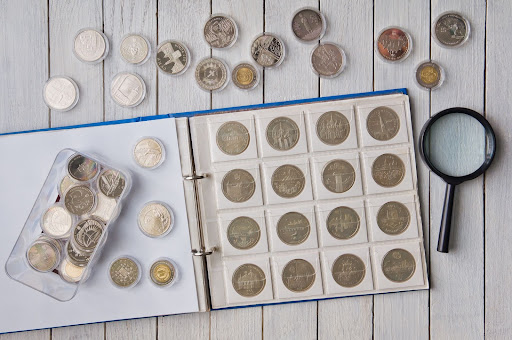Whether you’ve been collecting coins for decades or are just getting started in the coin collecting hobby, storing and tracking your coin collection is an essential part of keeping your coins organized. It’s a relatively simple process that will pay off when your coin collection is so extensive that it’s a sight to behold, or even when it’s time to pass it down to future generations.
If you’re serious about coins collecting as an investment, consider checking out Whitman Publishing’s Official Red Book: Check List and Record Book of United States and Canadian Coins. This will help you learn what your heirs and/or the IRS need to determine the value of your collection. Especially if you collect rare coins, gold coins, or silver dollars, these have been known to greatly increase in value over the decades and might wind up netting you a small fortune!
Here are some different methods for cataloging a coin collection:

Notebook
If you’re new to coin collecting or don’t have many coins, a notebook can be perfectly adequate for cataloging a coin collection. It can be helpful to make columns identifying characteristics about each specific coin, such as mint mark, purchase price, and year minted, as well as a column for your personal notes. The American Numismatic Association (an organization for coin collecting enthusiasts established over 100 years ago) and the United States Mint recommend using acid-free archival-quality paper to maintain your records so that the paper doesn’t yellow or wear out over the years. If you think you’ll be making changes to your records, it’s not a bad idea to write in pencil.
Checklist
If you have a goal in mind, such as collecting all the coins in one specific series, a checklist can be an easy way to accomplish your goal and keep track of your coins simultaneously. Checklists are versatile because they are available both online and just by making a list, although they aren’t the most ideal solution if you’re keeping track of many details about your coins. Including specifics about coin grading and size can become unwieldy quickly on a checklist, so as mentioned before, these are best used when you have a goal in mind.
Binder
A three-ring binder is a tried-and-true method of cataloging a coin collection that many coin collectors swear by. This is because you can both catalog and store your coins at the same time using insert sheets alternating with labels, meaning your records exist right alongside the coins they are describing.
Album
If you’re starting out with a relatively large collection already or are aiming to collect many more coins, an album might be an ideal choice for you. Many pre-made albums exist where all you need to do is insert the coin itself, and all the details are already recorded. Of course, this does mean you need to correctly pick the spot to put the coin, which can be more complicated in the case of older coins. Coin collector websites sell albums, folders, and other pre-made storage solutions that you may find helpful in showing off your specific or niche collections.
Spreadsheet
An Excel or Google Sheets spreadsheet can be a great way to organize your collection because you can calculate things like total value with the click of a button. Plus, a spreadsheet can be expanded infinitely, and you never run out of room like you might in an album or notebook. If you have your spreadsheet on your phone as well, it is an even more convenient and portable method of cataloging a coin collection.
Specialized Software
If the idea of using computer software for cataloging a coin collection sounds good to you, but you want a more structured approach or are very new to the hobby, there are both free and paid coin-tracking-specific software options available to help you organize your collection. Some software even has corresponding mobile apps that truly digitize the process of cataloging a coin collection.
Photographic Cataloging
While this isn’t a method of cataloging a coin collection that is best by itself, photographic cataloging best exists used alongside another coin organization technique on this list. As you collect coins, take high-resolution digital photos of each coin, establish a naming convention for the files, and either keep the images on a flash drive or SD card or within a cloud storage program. This can be a fantastic way to talk about your coin collection and show it off without having to haul every coin you own around to conventions or meetups. It also gives you peace of mind that your coins are safe at home or in their storage location, but you can still share them with other people!
A Penny Saved…
No matter what method of cataloging a coin collection you wind up using, coin collecting is a hobby that can be both rewarding and profitable. Do you have old coins you’re looking to have appraised? If you’re looking for coin appraisal near Boston, MA, The Jewelers & Loan Co. has you covered. Are you thinking about starting your own collection but need more knowledge on the topic? Read more about how old coin prices are determined, or get the facts about the difference between gold coins’ face value and actual value.
To get an idea of the true value of the collection you’ve worked so hard to build, contact us today!
